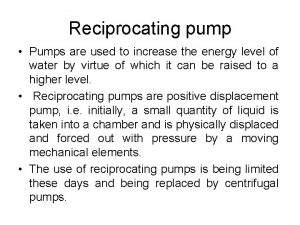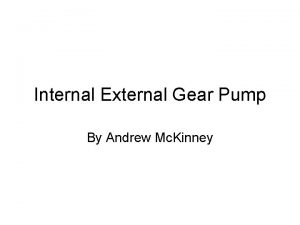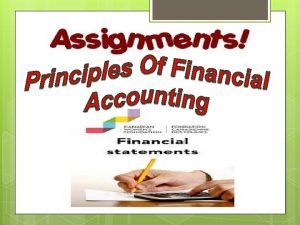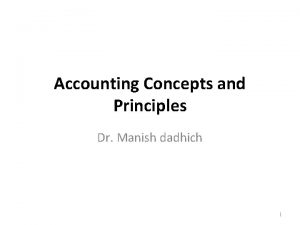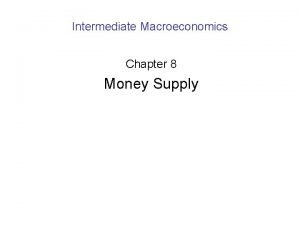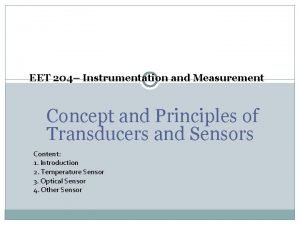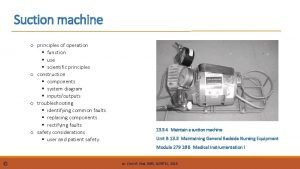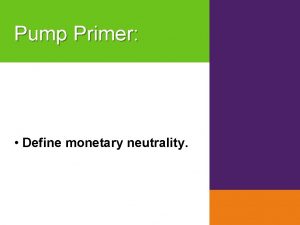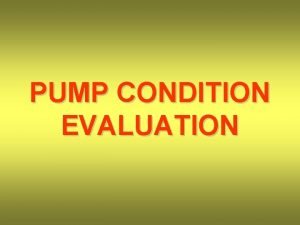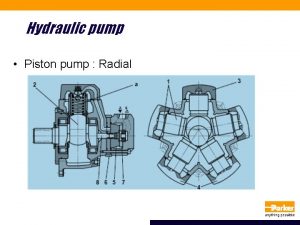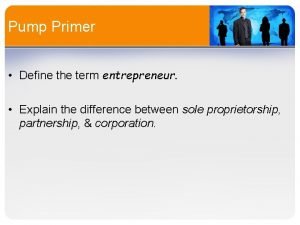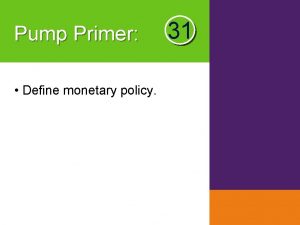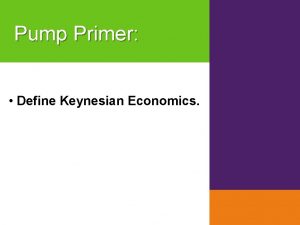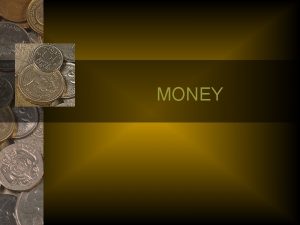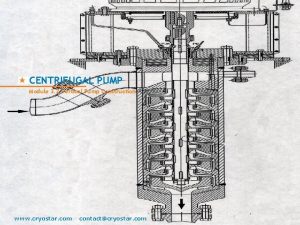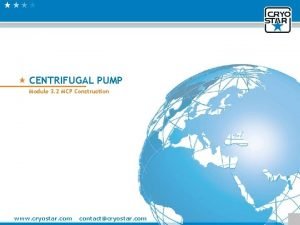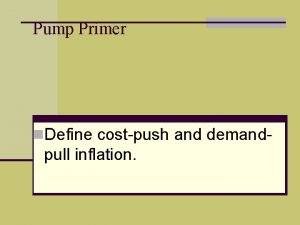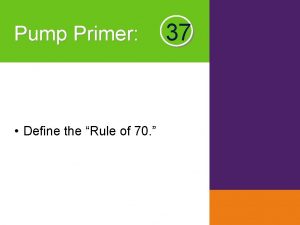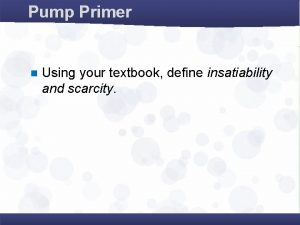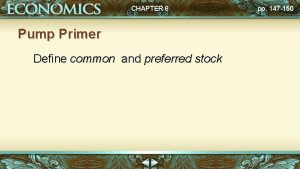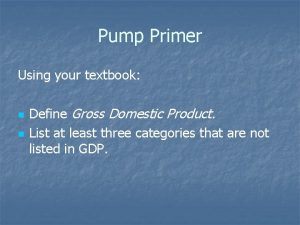Pump Primer Define Money Explain its Function Module



















- Slides: 19

Pump Primer • Define Money & Explain its Function.

Module 23 The Definition and Measurement of Money KRUGMAN'S MACROECONOMICS for AP* Margaret Ray and David Anderson

Biblical Integration • The Bible warns against covetousness and identifies it as idolatry (Col 3: 5). Money is a useful resource, however, the "love of money" leads a Christian down a pathway of destruction. (1 Tim. 6: 10) We need to therefore be very careful in remembering the true function that money plays within our lives.

What you will learn in this Module: • The definition and functions of money • The various roles money plays and the many forms it takes in the economy • How the amount of money in the economy is measured

What is money? I. The Meaning of Money and wealth are often confused. This section of the module provides a very easy way to separate money from other assets that have value.

What is money? What makes the $20 in your pocket different from your laptop computer or your cell phone? All three are assets, but only the $20 will be accepted by the gas station as payment for your gasoline and big gulp. Money is essentially anything that is easily exchangeable for goods and services.

What is money? Of course you could sell your laptop and cell phone, because they have value, and someone would give you money in exchange, and then you could buy gasoline and other items with that money. Or, you could give the gas station your laptop in exchange for the gasoline in your car, but then we are talking about barter, the exchange of goods for goods. As we will see, using money helps to eliminate the need for bartering.

Roles of Money While it seems that everything relies on money, money really only has three main roles in any modern economy: it is a medium of exchange, a store of value, and a unit of account.

Roles of Money 1. Medium of Exchange Your employer exchanges dollars for an hour of your labor. You exchange those dollars for a grocer’s pound of apples. The grocer exchanges those dollars for an orchard’s apple crop, and on. Without money, we would make such exchanges in a barter system. If I were a cheese maker and I wanted apples, I would need to find an orchard that also needed cheese, and this would be a supremely difficult way to do my shopping. “Double coincidence of wants. ”

Roles of Money 2. Store of Value So long as prices are not rapidly increasing, money is a decent way to store value. You can put money under your mattress or in a checking account and it is still useful, with essentially the same value, a week or a month later. If I were the town cheese maker, I must quickly find merchants with whom to exchange my cheese, because if I wait too long, moldy cheese loses its value.

Roles of Money 3. Unit of Account Units of currency (dollars, euro, yen, etc) measure the relative worth of goods and services just as inches and meters measure relative distance between two points. In the barter system, all goods are measured in terms of other goods.

Roles of Money Prices in a Barter Economy: A lb of cheese= dozen eggs = ½ lb of sausage = 3 pints of ale…. . With money, the value of cheese, and all other goods and services, is measured in terms of a monetary unit like dollars.

Types of Money Throughout human history, people have understood the important roles that money plays, but have chosen to use different types of money within their societies. Commodity money: something used as money, normally gold or silver, that has intrinsic value in other uses. If you didn’t want to use your gold or silver to purchase a covered wagon, you could have it melted and shaped into a piece of jewelry or a serving platter.

Types of Money Commodity-backed money: a medium of exchange with no intrinsic value whose ultimate value was guaranteed by a promise that it could always be converted into valuable goods on demand. This form of money appeared similar to our current paper currency and was used to make transactions. However, if you wanted, you could take the paper currency to a bank and exchange it for an equivalent amount of gold or silver.

Types of Money U. S. bill of any denomination: Is this commodity money? No. If I take this to the local bank, will they give me the equivalent amount of gold for this money? No, though it would be funny if you tried. Is it money at all? Yes! Says who? Hmmmm. The government. If you mow my lawn, and I give you some money for your labor, why should you accept it? Wouldn’t you rather have something useful like a block of cheese? So, what is so useful about this money? I can take it somewhere and buy something I really want (maybe cheese, maybe not).

Types of Money What if that store didn’t accept it? Some stores refuse to accept checks or debit/credit cards. Now show the class the small print on the front, bottom left, corner of the bill. It reads “This note is legal tender for all debts, public and private. ” This is a declaration from the U. S. government that you can use this money to pay your taxes (a public debt) or buy a slurpee (a private debt). Fiat money: money whose value derives entirely from its official status as a means of exchange. This is our paper and metal money today. It is our money because the government has decreed it to be our money. Everyone accepts it as payment for nearly anything, so it serves the purposes of money.

Measuring the Money Supply How much money is out there? It depends on what we define as money. The Federal Reserve, our central bank, has two aggregate measures of the money supply. First, we add up the money that is most easily used to make transactions (the most liquid).

Measuring the Money Supply M 1 = currency and coin in circulation + checking deposits + traveler’s checks Then, the Fed expands the definition to include “near monies” or forms of money that can fairly easily be converted to cash (slightly less liquid than M 1). Near monies pay interest while few items in M 1 pay interest.

Measuring the Money Supply M 2 = M 1 + savings accounts + short-term CDs + money market accounts (Note: In future modules about monetary policy, an increase in the money supply is really just adding to M 1 and M 2. )
 Money money money team
Money money money team Centrifugal pump vs reciprocating pump
Centrifugal pump vs reciprocating pump Internal external gear
Internal external gear Three screw pump
Three screw pump Tally for petrol pump
Tally for petrol pump Bio toc
Bio toc Tp analyzer
Tp analyzer Codtoc
Codtoc What is old money
What is old money Money smart money match
Money smart money match Money on money multiple
Money on money multiple Great gatsby satire
Great gatsby satire Context of the great gatsby
Context of the great gatsby C device module module 1
C device module module 1 What do you mean by accounting convention
What do you mean by accounting convention Boundary rules accounting
Boundary rules accounting Explain money measurement concept
Explain money measurement concept Explain the quantity theory of money
Explain the quantity theory of money Difference between voltmeter and potentiometer
Difference between voltmeter and potentiometer Principles of suctioning
Principles of suctioning

